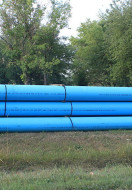Building Specs offers home inspections on outdoor wooden decks, we find that most of the damage to these areas could be avoided with some regular maintenance. There are a few schools of thought on this subject. One is to let the deck weather naturally and allow the wood to breathe. If the wood becomes discolored or has a mildew problem, you can use a mild mix of bleach and water to kill the mildew. There are chemicals on the market you may purchase, but some of them are harmful to the wood, and can cause the grain to raise. Be careful with power washing your deck, the pressure can severely raise the grain of the wood and cause further damage to the wood. Due to the water pressure, one deck swelled up so much, that once the decking dried out, the nails popped out one quarter
of an inch.
Decks may prematurely rot if they are in conditions where they stay damp all of the time. Some people will seal the deck to prevent moisture intrusion. This will repel the water so it can not enter into the grain and cause damage. Your decision should also be determined by the height of the deck. If the deck is too low to the ground, moisture may become trapped in the wood. The sealer can now act as a barrier and not let the moisture escape. This can cause mildew and fungus to become trapped under the sealer, in the wood and can lead to rot.
With wood you will need to determine what species of wood you have. Is it treated, cedar, redwood, cypress, fir or a wood that may be more susceptible to rot such as spruce or white pine? You may want to consult with a local paint supply company for the best product for your type of wood.
There are many sealers on the market so shop around and educate yourself. Some sealers have U.V. protectors that help in keeping the sun from fading the wood. There are stains that are translucent and have a pigment in them. These will allow the grain to remain visible and still protect the wood. The stains normally last longer than the clear sealers and can bring color back to a faded deck. The clear sealers will show the wood,s beauty, but depending on the deck,s location, exposure to the sun, dampness and traffic will affect the sealer's life.
You should routinely inspect your deck for rot , decay, cracking, settling and grain severely opening. Check all of the connections at the rail, ledger and stairs. Examine the stairs for cracking or failing treads. If your posts go below grade, look for any rot by using an awl or a sharp probe. If you suspect any problems call a professional to come and inspect the problem.







